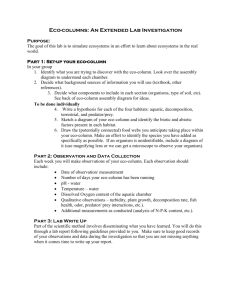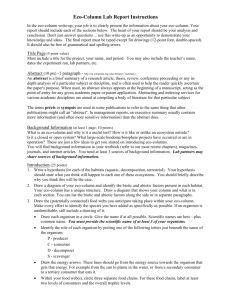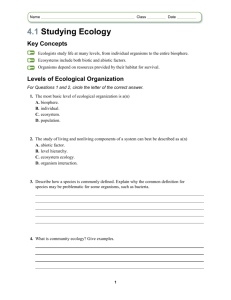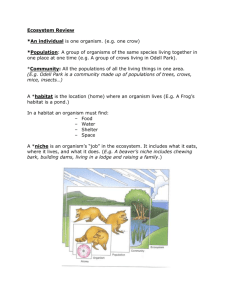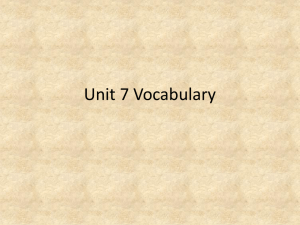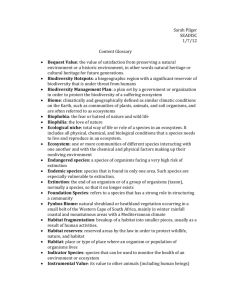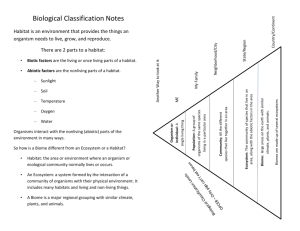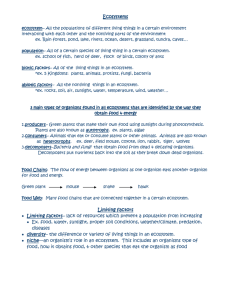Lab Write up instructions It is your job to clearly and neatly present
advertisement
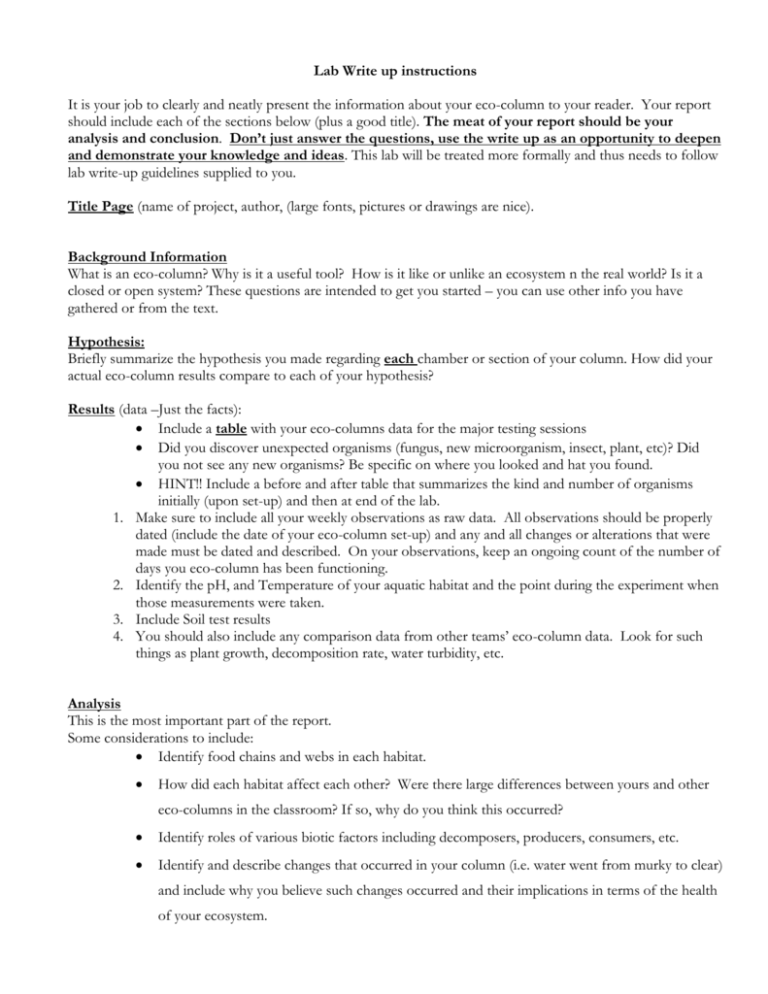
Lab Write up instructions It is your job to clearly and neatly present the information about your eco-column to your reader. Your report should include each of the sections below (plus a good title). The meat of your report should be your analysis and conclusion. Don’t just answer the questions, use the write up as an opportunity to deepen and demonstrate your knowledge and ideas. This lab will be treated more formally and thus needs to follow lab write-up guidelines supplied to you. Title Page (name of project, author, (large fonts, pictures or drawings are nice). Background Information What is an eco-column? Why is it a useful tool? How is it like or unlike an ecosystem n the real world? Is it a closed or open system? These questions are intended to get you started – you can use other info you have gathered or from the text. Hypothesis: Briefly summarize the hypothesis you made regarding each chamber or section of your column. How did your actual eco-column results compare to each of your hypothesis? Results (data –Just the facts): Include a table with your eco-columns data for the major testing sessions Did you discover unexpected organisms (fungus, new microorganism, insect, plant, etc)? Did you not see any new organisms? Be specific on where you looked and hat you found. HINT!! Include a before and after table that summarizes the kind and number of organisms initially (upon set-up) and then at end of the lab. 1. Make sure to include all your weekly observations as raw data. All observations should be properly dated (include the date of your eco-column set-up) and any and all changes or alterations that were made must be dated and described. On your observations, keep an ongoing count of the number of days you eco-column has been functioning. 2. Identify the pH, and Temperature of your aquatic habitat and the point during the experiment when those measurements were taken. 3. Include Soil test results 4. You should also include any comparison data from other teams’ eco-column data. Look for such things as plant growth, decomposition rate, water turbidity, etc. Analysis This is the most important part of the report. Some considerations to include: Identify food chains and webs in each habitat. How did each habitat affect each other? Were there large differences between yours and other eco-columns in the classroom? If so, why do you think this occurred? Identify roles of various biotic factors including decomposers, producers, consumers, etc. Identify and describe changes that occurred in your column (i.e. water went from murky to clear) and include why you believe such changes occurred and their implications in terms of the health of your ecosystem. Discuss the similarities and or differences between your artificial ecosystem and the ones in nature. What kinds of niches were available to various organisms? Were there limiting factors in your habitats? How did the plant life respond? Why do you think it responded this way? Were there color changes in any of the habitats (yellow, white, red, blue, etc) if so, what do you think caused the changes? Comment on the stability and sustainability of the various eco-columns in the classroom. Do some appear more stable or resilient than others? Discuss why you think this is so. Discuss the data for your eco-column with regard to your set-up. What does your data say about what has been going on in your column? What conclusions or generalizations can you make about the eco-column as a system and what connections can you make to other natural systems? 1. Choose one nutrient cycle (Water, Carbon, Nitrogen, Oxygen, Phosphorus) and diagram and explain how you think it would occur in your eco-column. Explain how the biogeochemical cycle affected the organisms living in your eco-column. 2. Draw a food web and identify the role of each organism by putting letters just beneath the name of the organism (P- producer, C-consumer, D-decomposer, D-detritivore). Make sure your food web has energy arrows going from the energy source towards the organism that gets that energy. 3. Identify the tropic levels in your eco-system. What would happen if the decomposers were removed? If the secondary consumer consumed 4,200 kilocalories of energy, how much energy would you assume was available to the primary consumer? Conclusions: What conclusions can you make about your eco-column? What connections can you make between the eco-column and a natural ecosystem or biotic community? (RERUN) RECALL (what you did) EXPLAIN (why) RESULTS (what you found support with data) UNCERTAINTIES (mistakes or unexpected things) Identify any weaknesses in your investigation. These could include equipment malfunctions, testing problems, collection errors, simple human mistakes. Sources of error could also include poor experimental design (set up). NEW THINGS (two things you learned) **You can use the template below to create your lab report. Use your Design Workbook handout as a guide. TITLE PAGE Title of Lab: Background Information: Hypothesis: Results/Data Analysis Conclusions:

